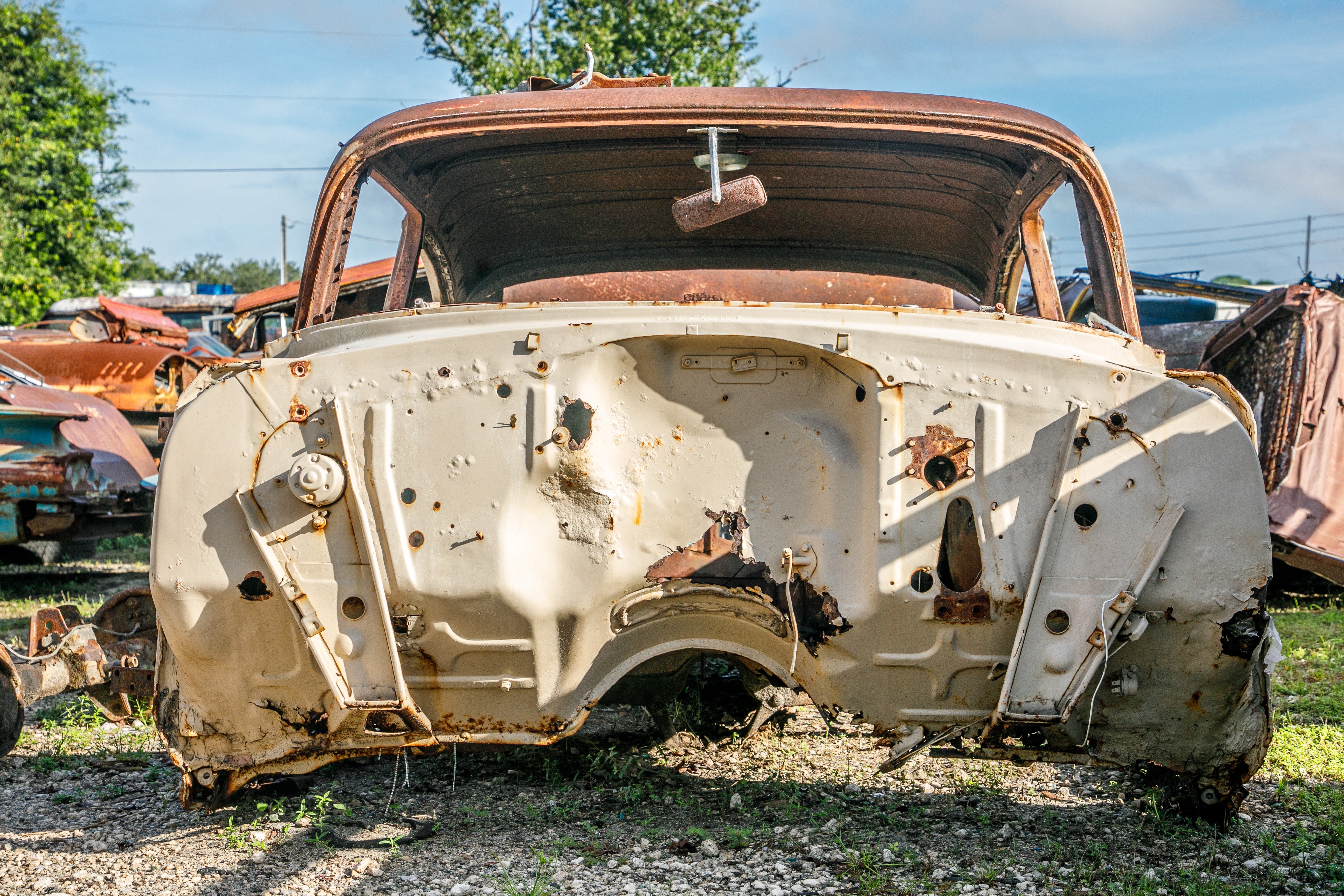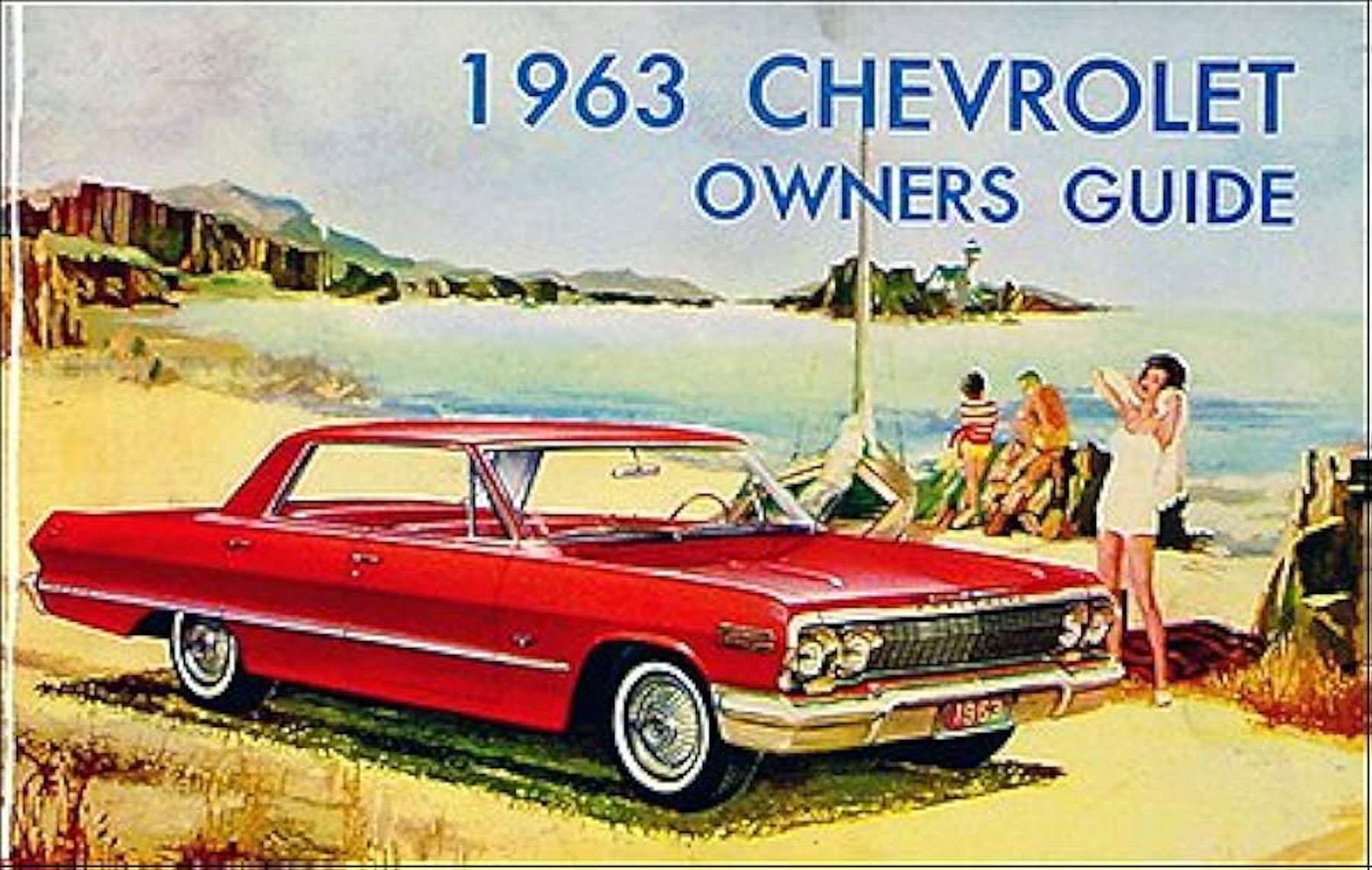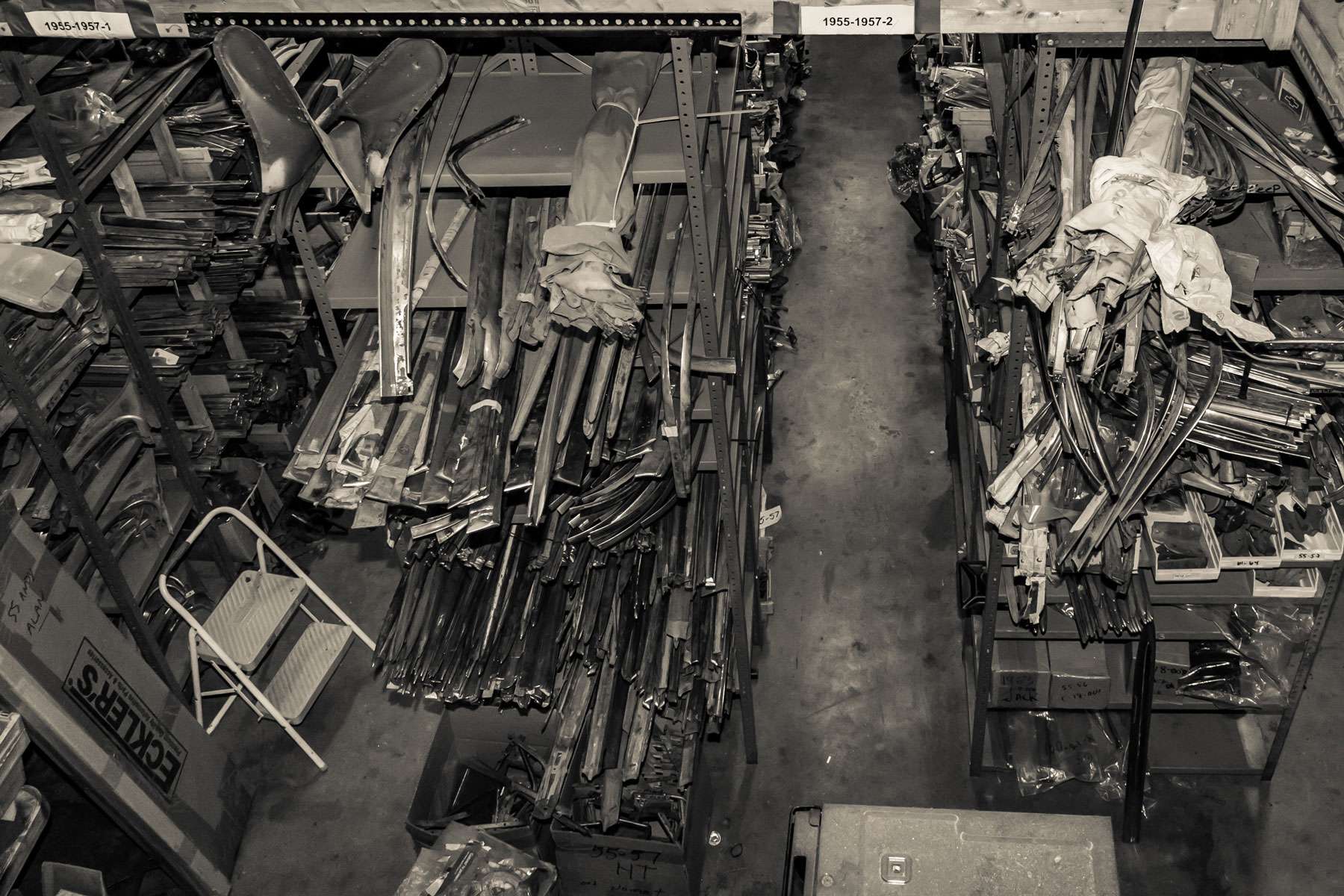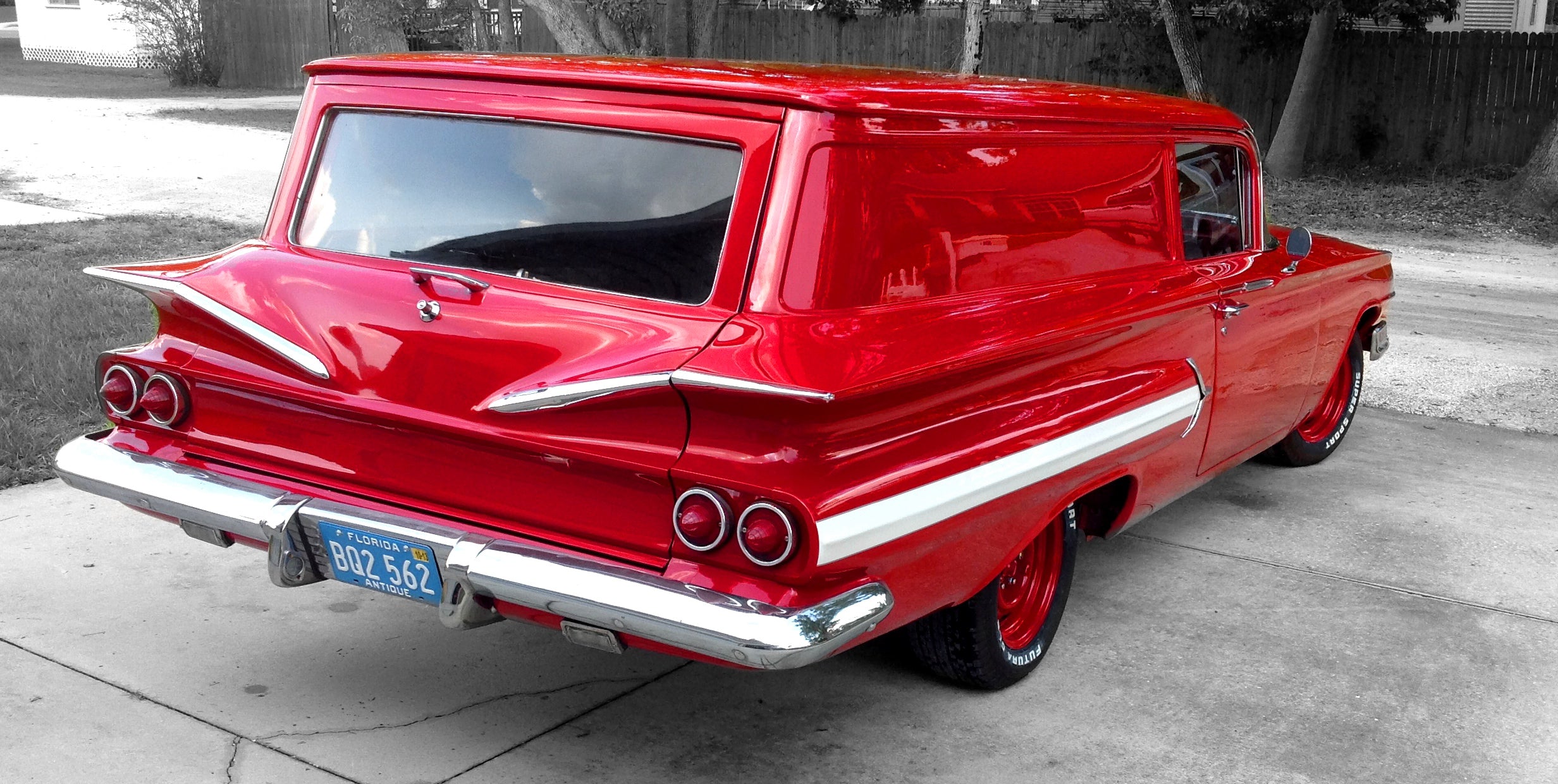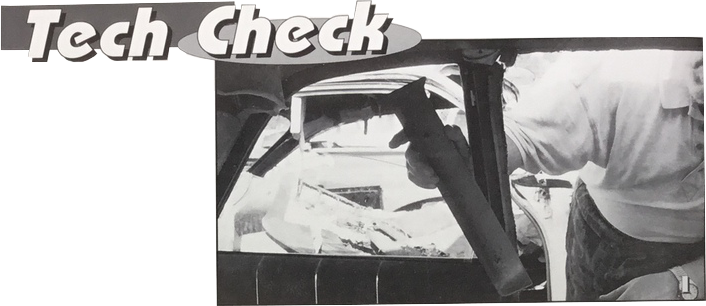
Quarter Window Channel Restoration for 2-door Sedans
This month's Tech Check continues the restoration of the window channels on 1961 & 1962 two-door Sedans - specifically the quarter window area. The article will explain the removal of the trim panel, quarter window & quarter window channel. The restoration of the quarter window channel assembly will be explained along with the re-installation of everything. Since the installation of the trim panel whisker strip is the same for the quarter trim panel as for the door trim panel, refer to last month’s article for that part of the restoration.
Because this area remained basically the same, this article should help anyone who is restoring any Late Great Chevy-2door Sedan. This article starts with the rear seat removed from the car.

Using a Philip screwdriver, remove the two sheetmetal screws which secure the rear arm rests to the panel. Using a handle clip removal tool, remove the window crank. Using a Philips screwdriver, remove the window crank. Using a Philips screwdriver, remove the two screws which secure the vertical pillar garnish molding. (See Photo #1)
Using a Philip screwdriver, remove the three screws which secure the garnish molding which goes across the top of the quarter window and down the back. (See Photo #2) Using a Philip screwdriver, remove the three screws which secure the vertical backglass garnish molding. Remove the quarter trim panel.

Using a small socket or wrench, remove the 8 sheetmetal screws which secure the large access hole cover. Remove the large access hole cover. Using a 7/16-inch socket, loosen the bolt and special washer which secure the front guide assembly of the rear quarter window. (Do not remove the bolt at this time.) (See Photo #3.)

Using a 7/16-inch socket remove the two bolts which secure the rear guide assembly of the rear quarter window. (See Photo #4.)

Slide the rear guide assembly off of the rear nylon roller of the quarter window and remove the guide assembly of the car. (See Photo #5)

Tip the part of the quarter window downward while rolling the regulator mechanism upward to slide the forward nylon assembly out of the forward guide assembly. Tip the forward edge of the window assembly into the car. Roll the regulator down until the window assembly is free of the regulator nylon roller and can be removed out of the quarter.
Using a 7/16-inch socket remove the bolt and special washer which secures the forward/lower bracket of the window channel assembly. (Refer to photo #36.) Using a flat-bladed screwdriver, pry the window channel assembly away from the body of the car. All of the clips are visible from the inside of the car and the whole channel assembly needs to slide inward towards the center of the car. (One clip is down inside of the quarter, just above the forward/lower bracket.) Using a flat-bladed screwdriver pry the rear bracket assembly out of the rear pillar of the body. There are two green push-in-type clips that secure this bracket. Remove the channel assembly out of the car and try to keep everything in act.
Using a Philips screwdriver, remove the two screws which secure the outer rubber weatherstrip with chrome bead. One of the screws is at the forward part of the strip and the other screw is at the rear. (See Photo #6.) Using a flat-bladed screwdriver, push the rubber weatherstrip downward into the quarter to release the clips which secure the strip.

It would be a good thing for you to carefully look at the orientation of the forward/lower bracket in relation to the “opening” of the clips that run along the length of the channel. (See Photo #7.) The forward and rear brackets for both the left and right side are identical, the only thing that you will have to be careful of is to install them correctly on the new window channels so that one forward/lower bracket is facing one direction and the other is facing the other direction. The clips must also mounted in a certain direction so that they will correctly secure the channel. The rear brackets are interchangeable and there is no special orientation. There are two styles of forward and rear brackets. I will refer to one set of them as the 1961-style brackets and the other type I will refer to as the 1962-style brackets. From looking at many cars, it appears that somewhere along the production year in 1961, the styles of these brackets changed.

For the 1961 style: Use a 1/4-inch bit to drill out the rivets of the forward/lower bracket. Use a small punch and hammer to drive the rivets out. On the 1961-style forward brackets, the bracket is a 2-piece bracket that is held together by the rivets that secure it to the window channel. (See Photo #8.) The rear bracket has the sides of the window channel pinched in place with some slotted tabs that run along the side of the bracket. Using a flat-bladed screwdriver, pry the slotted part of the bracket inward so that the channel is released. (Note that the bottom of the window channel ends where the rear bracket begins. (See Photo #9.) The remaining part of the channel that is attached to the rear bracket is only the sides of the channel. The reason the complete channel cannot be installed in the rear bracket is that when the window is rolled up and down the window tucks back into the bracket somewhat. You will also notice that the chrome bead ends with the end of the bracket.)
For the 1962 style: Use a 1/4-inch bit to drill out the two rivets that secure the bracket assembly to the window channel. (See Photo #10.) Use a small punch and hammer to drive the rivets out of the bracket. In this style bracket, the two parts of the bracket are spot-welded together. (See Photo #8.)



Use a sharp tool to mark each of the following pieces as “left” or “right”: the forward/lower channel brackets, and the rear channels brackets. At this time beadblast and then clear coat all of these pieces.
For 1961-1962 2-door Sedans there is almost no adjustment and very little tolerance designed into the quarter window channels. The window channel assemblies have to be very exact! I would suggest using a felt marker to mark a piece of window channel. You should place marks at the following locations: 3 1/2-inches; 7 1/4-inches; 13 1/2-inches; 21 3/4-inches; 26 3/4-inches; 35 7/8-inches; 44 3/4-inches; 48 3/8-inches and finally 53 7/8-inches which will be the end of the channel. Using some tin shears, cut the channel at the beginning of the channel and end at the 3 1/2-inch mark. The rear bracket will start at the 48 3/8-inch mark and end at the 53 7/8-inch end of the channel. All of the other measurements in between are the centers of the clips which will be installed.
The first bracket to be installed is the rear bracket. For those of you installing 1962-style rear brackets, skip to the next step. For those of you installing the 1961-style rear brackets use the following procedure; Using some tin shears, cut the bottom out of the channel up to 48 3/8-inch mark. (See Photo #11.) Do this carefully because the sides of the channel are quite delicate. The cloth cover will be loose and you may want to use some Trim Adhesive to glue the cloth cover back onto the metal backbone of the window channel. (See Photo #16.) This will sort of hold everything in place while you install the window channel into rear bracket. With the tabs of the rear bracket bent inward, position the channel sides into the three tabs. (See Photo #12.) Make sure that the chrome bead is flush to the bracket for the 2nd and 3rd tabs. Don’t try to bend the chrome bead for the last tab. Using a pair of pliers, squeeze the tabs into place. (See Photo #13.) Repeat this procedure for the other side of the bracket. At this time the bracket should be secured to the end of the window channel. Skip to Step #14.



For those of you with the 1962-style rear brackets, use this step to install the rear bracket. Using the tin shears, make a single cut down the center of the channel - from the end, up to 48 3/8-inch mark. (See Photo #14.)

Using some needle-nosed pliers, flatten out the channel so that the sides are flat and half of the bottom of the channel has now become part of the side. (See Photo #15.) The cloth cover is probably loose and you can use some Trim Adhesive to glue the cloth backing into place. (See Photo #16.)


To install the staples into the rear channel, a 3/8-inch thick block of wood is required. Position the wood into the channel and then slide the bracketing into place. Make sure that the chrome bead is flush with the edge of the bracket. Using a 3/32-inch bit, drill the holes for the first two staples. You will drill through the bracket, through the side of the window channel, and into the wood. (See Photo #17.) I would suggest just installing staples into the two of the three original locations. Remove the block of wood and position the staple through the bracket and through the window channel. (See Photo #18.) Use needle-nosed pliers to squeeze the ends of the staple together. Then use some regular pliers to finish the staples so that they firmly hold the window channel. Repeat this procedure for the other staples in the rear bracket.


The 6 retaining clips will now be installed onto the window channel. Use the marks on the window channel as the center of the clip. These clips will be installed onto the back of the window channel and they will all face one direction. The clips on one channel will all be facing one way and all the clips on the other channel will be facing the opposite way. No one is reproducing these very complicated clips so you must reuse the ones that you have.
Using some needle-nosed pliers, very carefully straighten the four tines that will hold the clip onto the window channel. (See Photo #19.) Position the block of wood inside the window channel. This block of wood needs to be deep enough so that when the wood is all the way into the channel, it is still protruding out of the channel at least 1/8 inch. You need an extra set of hands for the next few steps. With the block of wood and window channel on some very solid surface, such as a vice, position the clip and then use a flat window channel. (See Photo #20.)


Carefully remove the block of wood and then tip the channel clip over and position it onto the vice as seen in Photo #21. Notice that the center tab of the clips fits down into the opening of the jaws of the vice. With your finger, you can feel the tines as they stick up through the window channel. Using the flat-nosed punch and a hammer, drive the ends of the tines toward the outer edge of the window channel. Repeat this procedure for all four tines. This will secure the clip onto the window channel. Repeat the above procedure to install the other five clips. Make sure that they are all facing the same direction.

Before installing the forward/lower bracket onto your channel, I would suggest that both of the window channel assemblies be completed up to this point- where the rear brackets are installed and all the clips are installed. As mentioned above, one of the window channels should have the clips facing one direction and the other window channel should have all the clips facing in the opposite direction.
Now the forward/lower bracket will be installed. The bracket will be installed onto the end of the window channel so that the bracket faces in the opposite direction as the clip “opening”. (Refer to Photo #22 so that you can see how the brackets faces with relationship to the “opening” of the clip.) These brackets will be installed using two oval-head semi-tubular rivets. These rivets will be installed the same way that the rivets were installed in last month’s Tech Check article. (Refer to Step #16 on page 8 of the December 1996 issue of Late Great Chevys.)

Position the block of wood into the window channel and then position the bracket onto the window channel so that the end of the window channel is flush with the end of the bracket. Using a 9/64-inch drill, drill two holes for the rivets. (See Photo #23.) You will be drilling through the window channel and into the block of wood. Remove the block of wood and then through the bracket. The head of the rivet will be down inside of the window channel.

To flair the rivets, I used a 3/8-inch thick piece of steel plate which was held in a vice. (See Photo #24.) Again, if you have an extra set of hands available, have them help you hold the bracket, the channel, and the rivets over the steel plate. Use a flat-nose punch and hammer to flair the rivets. (See Photo #25.) Repeat this procedure to install the other bracket onto the other channel assembly. At this point, the two window channel assemblies with brackets should be exact mirror images of each. They are now ready for installation.


This article will not address the installation of the whisker strip onto the new quarter trim panel. You can refer to your last month’s Tech Check article (Steps #19-#24). Those steps will explain how to prepare the top rails and how to install the whisker strips that need to be installed onto the quarter panels. The whisker strip and the rubber weatherstrip for the quarter are part of Part #34-70A.
Working from the outside of the quarter, use your hands to “pull” the rubber weatherstrip onto the metal lip of the quarter. These two clips are very strong and quite a bit of pressure must be applied to pull them into place.
Once the rubber weatherstrip is in place, the forward and rear screws can be installed. Use a grease pencil to mark the location of the rear screw which will secure the rear part of the rubber weatherstrip. This mark will help you find the screw hold in the quarter. Mark the position of the forward screw in the same manner. When using an awl to find these howls, this mark will come in handy. It takes a little pressure to press the awl through the metal “backbone” of the rubber weatherstrip piece. After making the hole in the weatherstrip, find the hole in the quarter and then reinstall the special flat-head #8 x 1/4-inch Philips flat-head sheetmetal screw. Repeat this procedure for the other hole.
At this point the window channel assemblies can be reinstalled into the quarters. All of the photos will show the installation of the left window channel assembly. Make a mark at the 25-inch location and use your thumbs to begin the bend which will come at the top/forward location of the quarter window. (See Photo #26.) Make it a somewhat rounded bend. Do not try to make it a sharp bend at this time. Make sure that the chrome bead is sliding “out” of the channel as you make the bend - this is normal.

From the inside of the car, slide the rear bracket into the quarter while at the same time sliding the forward/lower bracket into the quarter. (The photos show the person working from the outside of the car, actually, that was for photographic purposes only. You should be working the small access hole pointed out with the arrow, guide the rear bracket into position, and snap the green oxide clips into place. (See Photo #27.) Working from the rear of the channel, begin to snap the clips into the slots in the body of the car. Continue to snap them into place across the top of the quarter window opening and down the forward pillar. (See Photo #28.) If by some chance one or more of these clips are missing, some #8 x 1/2-inch flat-head sheet metal screws can be used to secure the window channel up into the body. As pointed out in Photo #29, there is one clip that is accessible through the hole that is pointed out with a screwdriver. Snap that clip into place also.



Before finishing the installation of the window channel assembly, the quarter window and guides will be installed. This window assembly is not one of the easier installations that GM has designed, but with the help of another person and some patience, it can be installed without a whole lot of trouble. Select the quarter window, the forward guide, and the rear guide for the left side of the Sedan. With some white lithium grease, lubricate the channel which is spot-welded to the bottom of the quarter window, the long forward guide assembly, and rear guide assembly. Orient the forward guide as shown in Photo #30 and slide the forward nylon bushing into the channel. The open part of the channel will be facing the outside of the car.

Turn the quarter window and guide assembly perpendicular to the side of the car so that you can slide the lower end of the guide down in the quarter. Also, tilt the forward edge of the glass down into the quarter. This will slide the forward nylon roller all the way down the guide. Start with the window regulator in the “down” position. Using the window crank, slowly start to roll the regulator up. As the rear arm of the regulator comes up, guide the regulator’s nylon roller into the lower channel that is spot-welded to the bottom of the window as seen in (Photo #31.) Continue to roll the window upward and begin to orient the glass horizontally as it comes up out of the quarter. Make sure that the forward/top corner of the glass is sliding in the window channel assembly. Make sure that the roller stays in the lower channel that is spot-welded to the bottom of the window, and make sure that the forward nylon roller of the quarter window does not come out of the forward guide assembly. (Doing all of this is not easy - remain patient!)

With the quarter window in the half-up position, start to thread the special bolt and washer which will secure the upper part of the forward guide assembly as pointed out with the flat-bladed screwdriver in (Photo #32.) Continue to roll the window upward until it is almost 3/4’s of the way up and the install the bolt and special washer which secures the lower end of the forward guide as pointed out with the flat-bladed screwdriver in (Photo #33).


After the window is rolled up completely, install the rear guide onto the rear nylon of the quarter window. In (Photo #34), you can see the basic orientation of the guide as you install it through the large access hole. Install the two special bolts and washers which will secure this rear guide. Do not tighten these bolts at this time.

Now that the window glass is installed, the forward/upper bend of the window channel assembly can be finished. Use a paint mixing stick (held perpendicular to the window channel assembly) to “nudge” the bend into the position. Do not “drive” the window channel assembly such that it leaves a “kink” in the window channel. (See Photo #35.) Once the window channel assembly is where you want it, install the special bolt and washer which secures the forward/lower bracket of the window channel assembly as pointed out in Photo #36.


You can adjust the quarter window a small amount. The forward part of the window can be adjusted upward by securing the forward guide in its most upward position. The rear part of the window assembly can be adjusted upward by securing the rear guide in its most upward position. After you have adjusted the glass, secure the two bolts for the rear guide and the two bolts for the forward guide.
At this time the new quarter trim panel can be installed along with the rest of the garnish moldings, arm rest, and window crank. This installation would be the reverse order of Step #1.
Repeat Steps #22-#31 for the right side of the sedan. Great job!
